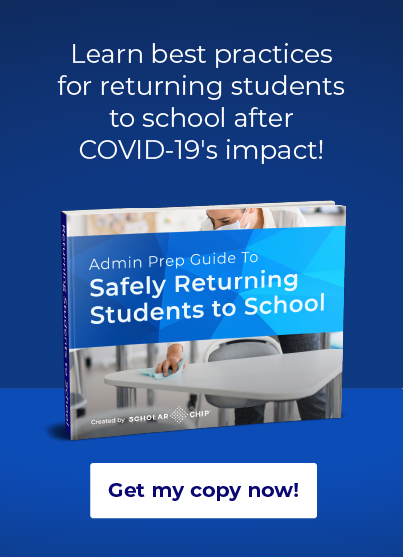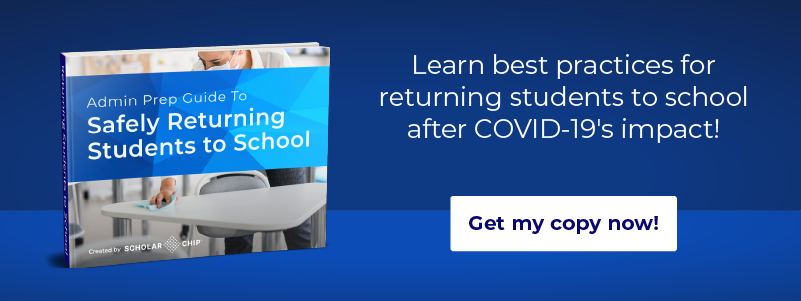It’s a new school year, with pressure to reopen schools, but we’re again faced with a rising number of COVID-19 cases in our communities.
It’s clear why school officials are as concerned today as they have ever been with safely welcoming students back to the learning environment. The landscape is uncertain: will there be more shutdowns? Will staff be able to keep up with the required cleaning and sanitizing? What if an outbreak happens? How will the pressure of the last year—combined with the documented learning loss that has occurred with most students—impact the way that students act and react within the classroom?
The federal government has not been blind to the challenges that school officials face during these unprecedented times. Earlier in 2021, the Elementary and Secondary School Emergency Relief Fund (ESSER Fund) was passed. It is intended to provide financial support through grants to both state educational agencies and local educational agencies (LEAs).
ESSER funds can help reopen schools with greater confidence, increased staff, and better equipment and protocols in place. But the influx of money from ESSER can do more than that. Used well, these funds can help protect students and staff today and improve school safety and the environment well into the future.
Reopening Concerns
There is so much to think about when it comes to reopening. Administrators need to consider the everyday logistics—something that both staff and students are out of practice with—and the added factors of increased cleaning schedules, physical distancing, and whether masks are recommended or required.
But these considerations are just the tip of the iceberg. Building upgrades may need to be completed, such as air filtration systems. A host of new vendors may be introduced to the building as cleaning protocols are enhanced. Shared spaces need to be monitored closely. Should an outbreak occur, administrators need to keep close tabs on who was where, so they can support contact tracing efforts.
Also, learning loss has been documented for nearly every student group at every academic level, putting students back months. This stands to increase frustrations for staff, students, and parents.
There are all areas where ESSER funds can help. So, the question isn’t, “How do I make this happen on my current budget?”, it’s, “How do I make the most of the funding that my school will receive?” The right investments will add layers of safety and security for everyone, but not every potential investment is obvious.
Ways to Safely Reopen Schools
Infrastructure Investments
ESSER includes infrastructure improvements as part of the allowed expenses for LEAs, as does President Biden’s education plan proposal. Schools will find that they have enough budget for projects like better ventilation and enhanced cleaning protocols.
These projects will benefit schools and students as districts reopen, but it also means a string of visitors entering and leaving campuses on a regular basis.
Districts should consider allocating some of the money provided through ESSER to support their visitor management systems. A proper visitor management system will enable the rapid validation of visitors through automated ID scanning. These visitors can be checked against current, up-to-date sex offender lists. They can also be tracked, tagged, and monitored, and information about their visits can be easily accessed for activities like contact tracing if needed.
A comprehensive visitor management system can integrate with your existing SIS system, giving school administrators and office staff a complete view of attendance and pick-up authorizations. Mitigating the chaos of reopening schools, these systems working together will prevent mistakes with student pick-ups and drop-offs.
Lunchroom Safety
As a shared space, lunchrooms can be hectic and provide an ideal environment for spreading germs. Ideally, schools will want to limit access to lunch areas only to authorized staff and students and at most, accompanied visitors.
Any tool that can help maintain a calm and controlled lunchroom will help minimize anxiety and potential issues. For instance, getting students their meals quickly, without payment issues or questions, can help smooth the process.
When a school uses smart ID cards, students have access to a contactless system to pay for meals or access their lunch programs, all while minimizing touchpoints for infection. These cards can also be used to grant or restrict access to lunch areas, preventing unauthorized access.
Enhanced Attendance Systems
Understanding current and historical attendance and being able to analyze the data will be key elements as schools reopen. Contact tracing in particular will rely heavily on attendance records, so these will need to be up to date, accurate, and easily accessible to administrators and staff.
Smart ID cards can ensure visibility for attendance and the areas of a school that a student or staff member may have accessed during the day and whom they had contact with.
The added benefit of accurate attendance tracking is the ability to surface data quickly for students struggling to get to school. Chronic absenteeism and truancy can be identified quickly with easy-to-read dashboards. Finding these students early can be pivotal in giving them additional support to get their school careers back on track, as both issues can be red flags.
Addressing Learning Loss and Classroom Behavior Monitoring
Studies show that nearly all students have experienced some level of learning loss during the pandemic. This not only sets students back, but the increased pressure can also result in them acting out in the classroom or experiencing other behavioral issues.
Repeated outbursts can signify that a student feels frustrated or lost and could benefit from additional help, support, or counseling. Classroom disruptions can also impede the progress of other students trying to get back on track and make them feel unsafe within the school.
It can be difficult to discern between the occasional meltdown and a pattern of disruptive behavior, however. Tools that track classroom behavior along with attendance give schools a complete view of any student challenges, behavior patterns, and history so counselors and administrators can step in to offer the help and support that the student needs.
Conclusion
The defined uses for ESSER funds are open and fairly flexible. The key to using the fund effectively is to consider short-term goals for school reopening and long-term safety and student support goals. Viewed in the context of broader safety measures, ESSER can provide opportunities to enhance the learning environment in ways that may not come around again any time soon. These funds will provide schools—especially those that were previously lacking slack in their budgets—to implement processes and technologies that go beyond today’s health concerns and address the continued safety and security of the learning environment.
The ScholarChip team is dedicated to helping school leaders maximize the safety and well-being of students and the entire school community.
Want to talk more about creating an actionable plan for these funds to help close the learning loss and make reopening effective and safe? Feel free to chat with one of our specialists today!


